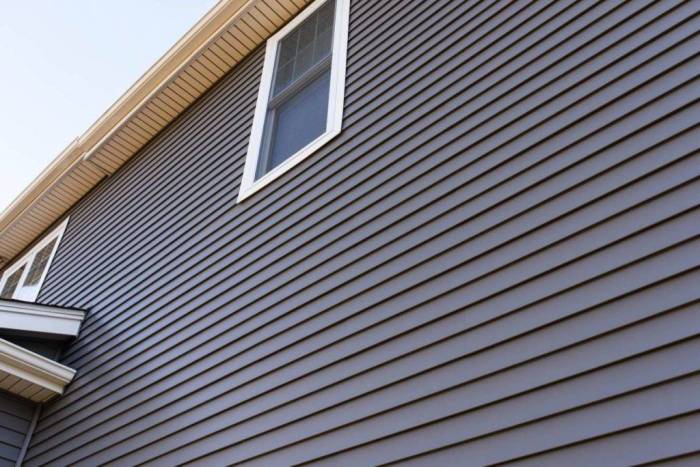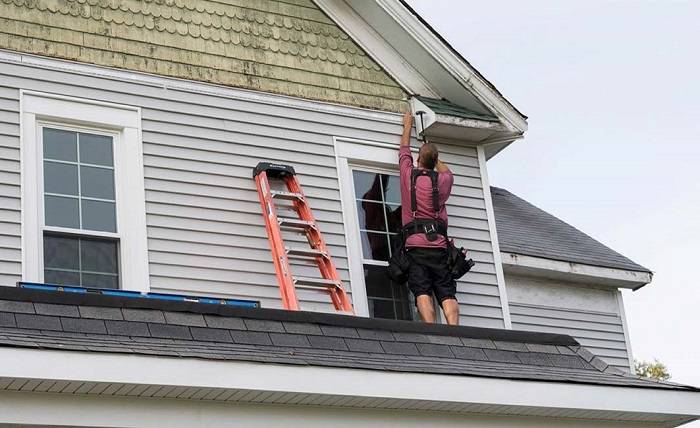Delving into the realm of vinyl siding labor, this introduction aims to provide a comprehensive overview of the costs, skills required, installation process, and safety measures involved. Stay tuned to uncover the ins and outs of vinyl siding labor.
Vinyl Siding Labor Costs

When considering the cost of vinyl siding labor, it's important to understand the typical breakdown of these expenses. The cost of labor for vinyl siding installation usually includes the following components:
- Removal of existing siding, if necessary
- Preparation of the exterior surface
- Installation of vinyl siding panels
- Trim work and finishing touches
Professional Installation vs. DIY Installation
Professional installation of vinyl siding can be more expensive upfront compared to a DIY installation. While hiring professionals ensures quality work and timely completion, it comes at a higher cost due to labor fees. On the other hand, opting for a DIY installation can save on labor costs but may require more time, effort, and skill on the homeowner's part.
Factors Influencing Labor Costs
Several factors can influence the variation in labor costs for vinyl siding installation. These factors include:
- The size and complexity of the project
- The condition of the existing exterior surface
- The accessibility of the installation area
- The location and local labor rates
- The experience and reputation of the installation crew
Skills and Expertise Required

To efficiently install vinyl siding, professionals need a combination of skills and expertise to ensure a high-quality finish and long-lasting results. From precise measurements to attention to detail, here are some key requirements for vinyl siding labor:
Skills and Expertise
- Knowledge of building codes and regulations: Professionals must be well-versed in local building codes to ensure compliance and safety during installation.
- Measurement and cutting skills: Accurate measurements and precise cutting of vinyl siding panels are crucial for a seamless and professional look.
- Attention to detail: Professionals should have a keen eye for detail to spot any imperfections or issues during the installation process.
- Problem-solving abilities: Being able to troubleshoot and solve unexpected challenges that may arise during the installation is essential for a successful project.
- Communication skills: Effective communication with clients, team members, and contractors is key to ensuring a smooth and efficient installation process.
Training and Certifications
- Certifications: Some professionals may have certifications in vinyl siding installation from organizations like the Vinyl Siding Institute, demonstrating their expertise and commitment to quality work.
- On-the-job training: Many professionals gain experience and expertise through on-the-job training with experienced contractors or through apprenticeship programs.
- Continuing education: Staying up-to-date on the latest industry trends, techniques, and technology through workshops, seminars, and courses is crucial for professionals in vinyl siding labor.
Specialized Tools and Equipment
- Vinyl siding cutter: A specialized tool designed to make precise cuts on vinyl siding panels for a perfect fit.
- Nail gun: Used to securely fasten vinyl siding panels to the exterior of a building, ensuring a strong and durable hold.
- Level: Essential for ensuring that vinyl siding panels are installed straight and level, preventing any uneven or crooked finishes.
- Snap lock punch: A tool used to create tabs on vinyl siding panels for a secure and interlocking installation.
- Ladder: To reach higher areas of a building for installation, repair, or replacement of vinyl siding.
Vinyl Siding Installation Process
Installing vinyl siding involves several steps to ensure a successful and durable outcome. From preparation to finishing touches, each stage plays a crucial role in the overall installation process.
Preparation
Before beginning the installation, it is essential to prepare the area by cleaning and inspecting the walls for any damage or rot. Make sure to measure and cut the siding panels accurately to fit the dimensions of the wall.
Installation
- Start by installing the starter strip at the bottom of the wall, followed by corner posts and J-channels around windows and doors.
- Begin installing the siding panels from the bottom up, making sure to overlap each panel correctly to prevent water infiltration.
- Use a nail slot punch to create slots for the nails, allowing the siding to expand and contract with temperature changes.
- Secure the panels in place with nails, but be careful not to overdrive them, as this can cause the siding to buckle.
Common Challenges and Issues
During the installation process, common challenges may arise, such as misaligned panels, buckling, or improper nailing. It is crucial to address these issues promptly to ensure a professional finish and prevent future problems.
Tips for Success
- Take your time to ensure accurate measurements and cuts for a precise fit.
- Use the right tools and equipment for the job to make the installation process smoother.
- Pay attention to detail and follow manufacturer guidelines for proper installation techniques.
- Consider hiring a professional installer if you are unsure about tackling the project yourself.
Safety Precautions and Regulations
When it comes to vinyl siding installation, safety should always be a top priority. Following the necessary precautions and regulations will not only protect the workers but also ensure a successful and efficient installation process.
Safety Precautions During Vinyl Siding Installation
- Always wear proper safety gear such as gloves, goggles, and hard hats to protect against potential hazards.
- Use ladders and scaffolding properly to prevent falls and injuries. Make sure they are stable and secure before climbing.
- Avoid working in extreme weather conditions such as high winds or icy surfaces to prevent accidents.
- Handle tools and equipment with care to prevent injuries. Follow manufacturer's instructions for safe usage.
Regulatory Guidelines and Building Codes
- Check local building codes and regulations before starting any vinyl siding installation project. Make sure you are in compliance with all requirements.
- Some areas may have specific guidelines regarding the type of materials that can be used or the installation process that must be followed. Be aware of these regulations to avoid any issues.
Importance of Proper Safety Gear and Practices
- Proper safety gear, such as gloves and goggles, can prevent injuries and accidents during installation. It is essential to wear them at all times.
- Following safe practices, such as securing ladders and scaffolding properly, can prevent falls and other accidents on the job site.
- By prioritizing safety, you not only protect yourself and your team but also ensure a smooth and successful vinyl siding installation process.
Final Conclusion
Wrapping up our discussion on vinyl siding labor, we have explored the key aspects of costs, skills, installation process, and safety precautions. Hopefully, this information equips you with valuable insights for your next vinyl siding project.
Questions and Answers
What are the typical cost breakdowns for vinyl siding labor?
The costs usually include labor, materials, and any additional services required for the installation.
What skills and expertise are needed for efficient vinyl siding installation?
Proficiency in measuring, cutting, and securing siding panels is crucial for a successful installation.
Are there any regulatory guidelines related to vinyl siding labor?
It's important to check local building codes to ensure compliance with regulations regarding siding installation.
